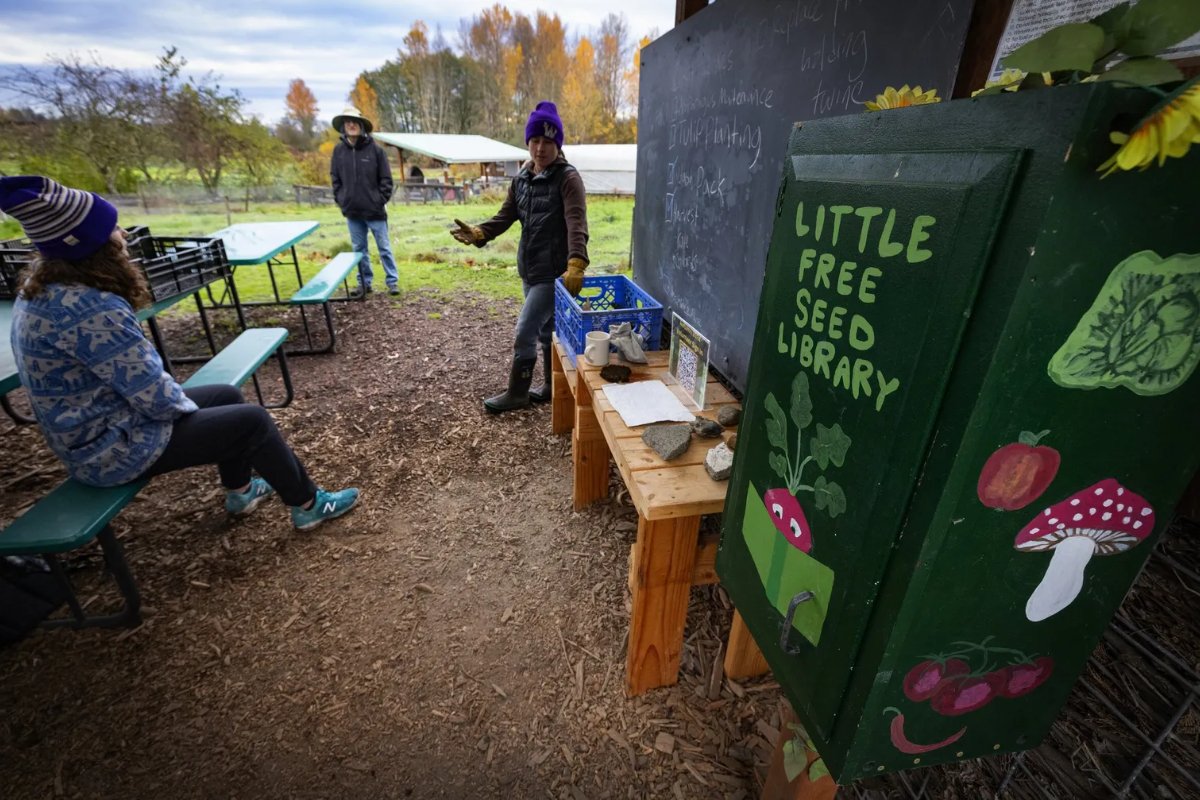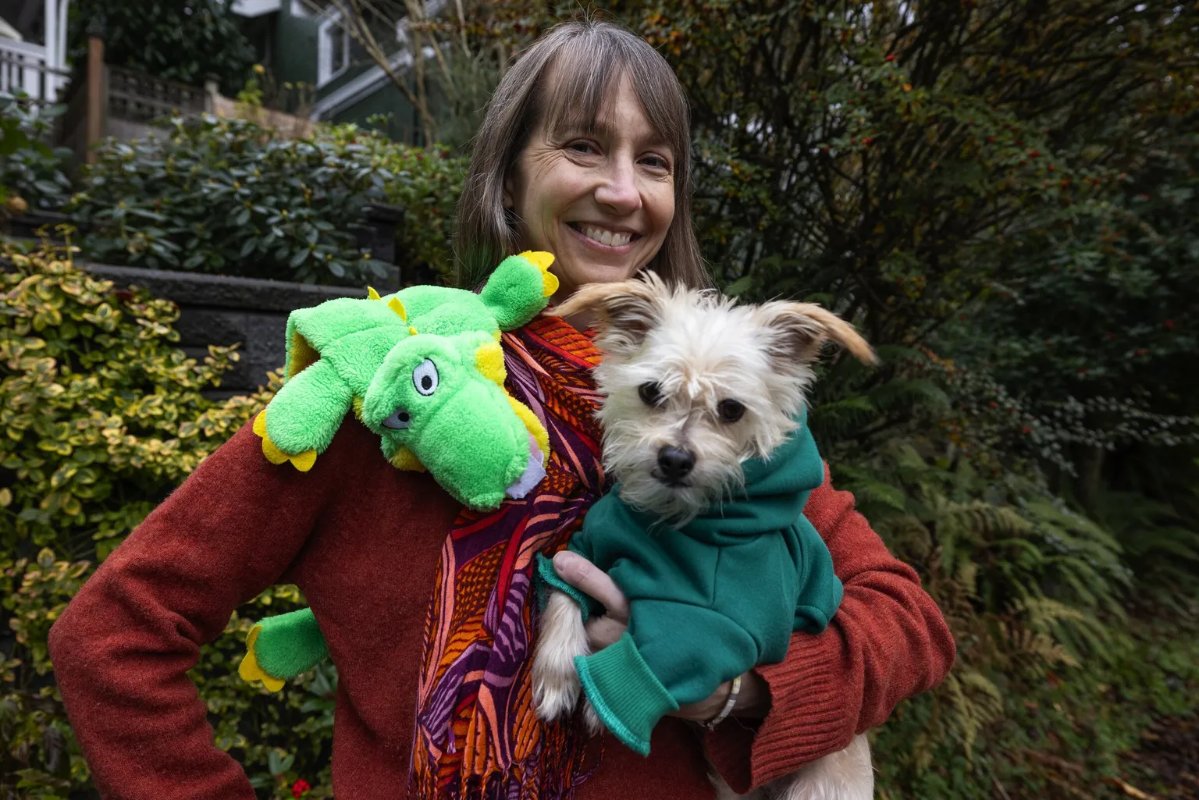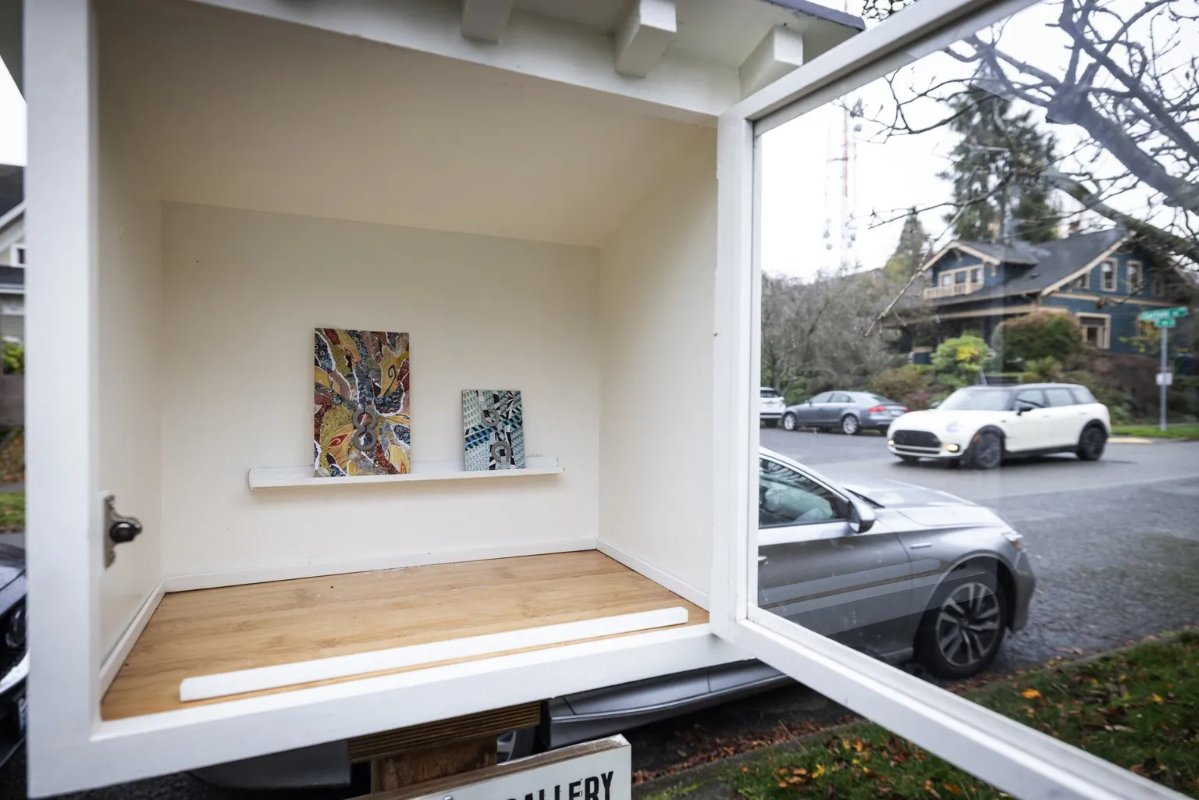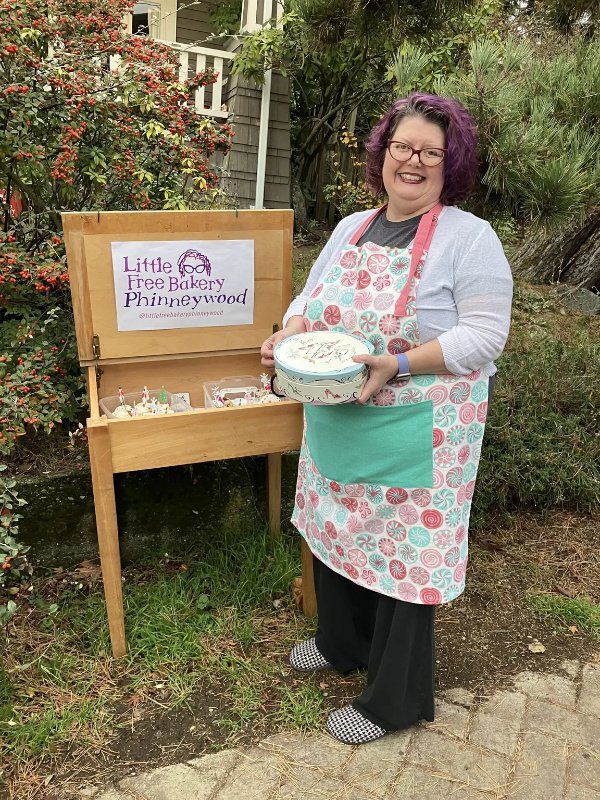The Little Free book idea has spread to other community-sharing opportunities, like a Little Free bakery, a crop of Little Free seed libraries, and much more.

The Little Free book idea has spread to other community-sharing opportunities, like a Little Free bakery, a crop of Little Free seed libraries, and much more.
January 13, 2025

Volunteers gather near the Little Free Seed Library at the Center for Urban Horticulture while listening to UW Farm production manager Aisling Doyle Wade, right, go over the day’s schedule. The group of almost a dozen volunteers will learn about compost, and then some will inventory seeds, with many going into the library. (Photo credit: Ken Lambert/The Seattle Times)
This article first appeared in Pacific NW Magazine, the Sunday magazine of The Seattle Times, and has been republished with permission.
Expand your understanding of food systems as a Civil Eats member. Enjoy unlimited access to our groundbreaking reporting, engage with experts, and connect with a community of changemakers.
Already a member?
Login
Spooning buttercream into a pastry bag, Kim Holloway is close to opening time. She pipes rosettes of frosting on trays of vanilla cupcakes—some plain vanilla frosting, some cookies and cream.
With the aid of Holloway’s “partner in crime,” Kathleen Dickenson, they prop the lid of an old-fashioned school desk in Holloway’s front yard and fill it with cupcakes. Holloway adds edible pearls and glitter. Shortly after 3 p.m., the Little Free Bakery Phinneywood is open for business—the business of sharing.
“I love to bake, and many people have told me, ‘Oh, you should open a bakery.’ And I just think, ‘No, no, no, no. It would take the joy out of it for me,” Holloway says.
“To me, the seed library is part of food security. It’s like having money in the bank, but it’s seeds in the library.”
Like hundreds of other Little Free hosts in the region, she’s found joy instead in giving.
And, like so many good ideas, this one started with a book.
In 2009, a Wisconsin man named Todd Bol built a Little Free Library in his front yard, encouraging passersby to take a free book or drop off extras. The idea and the format—a wooden box set on a post, usually with a latched door—seeded a movement, with more than 150,000 registered worldwide.
“Seeded” got literal fast: The Little Free book idea spread to other sharing opportunities, including a rampant crop of Little Free Seed Libraries, where people swap extra packets of cilantro and Sungolds.
Seattle’s density, temperate climate, walkable neighborhoods—and maybe our introvert culture?—make it easy for the little landmarks to thrive. They exploded during the COVID-19 pandemic, when locals thought outside the box by putting up a box, including what’s believed to be the nation’s first Little Free Bakery and first Little Free Art Library. Many built on the region’s existing affinity for hyperlocal giving—the global Buy Nothing phenomenon, for one example, was founded on Bainbridge Island.
“We just seem to do more of all these versions of sharing,” says “Little Library Guy,” the nom de plume of a longtime resident who showcases the phenomenon on his Instagram feed and a helpful map.
The nonprofit organization now overseeing global Little Free Libraries finds the nonbook knockoffs “fun and flattering,” communications director Margret Aldrich says in an email. (She also notes “Little Free Library” is a trademarked name, requiring permission if used for money or “in an organized way.”)
Some libraries stress fundamental needs: A recently established Little Free Failure of Capitalism in South Seattle provides feminine products, soap, chargers, even Narcan. A Columbia City Little Free Pantry established by personal chef Molly Harmon grew into a statewide network for neighbors supporting neighbors.
Others are about the little things: Yarn. Jigsaw puzzles and children’s toys. Keychains (one keychain library in Hillman City has a TikTok account delighting 8,000+ followers). A Little Free Nerd Library holds Rubik’s Cubes and comic books.
Regardless of where each library falls on Maslow’s hierarchy of needs, they stand on common ground. “There’s a line from [Khalil] Gibran: ‘Work is love made visible,’ ” Little Library Guy says in a phone call. “That’s what they’re doing. They’re showing that they love the community by doing something for them.”
Here’s a little free sample of what you might find around town:

Two University of Washington students sort, count, and bag mammoth sunflower seeds during an annual seed inventory inside a research facility at the Center for Urban Horticulture. These are seeds that birds at the UW Farm did not get to, and they’ll go into the Little Free Seed Library by the end of the day. (Photo credit: Ken Lambert/The Seattle Times)
At the UW Farm, on 1.5 acres of intensively planted land at the Center for Urban Horticulture, students grow more than six tons of organic produce annually. They learn about agriculture and ecology while providing food for 90 families in a neighborhood CSA, for college dining halls and for food banks.
One chilly November day, students and volunteers on the self-sustaining farm worked with the small staff to inventory what seemed like countless seeds for next year’s plantings: Parade onions, Autumn Beauty sunflowers, Painted Mountain corn, Genovese basil. Packs with just a small number of remaining seeds were set aside for the Little Free Seed Library installed near rows of winter greens.
Farm manager Perry Acworth organized the little library during the pandemic, seeing the renaissance in home gardening coupled with a run on supplies. “Seeds were sold out … even if they had money, they couldn’t find them,” she says.
Acworth picked up a secondhand cabinet—one with a solid door, rather than the usual Little Free Library glass window, because seeds need to be protected from light. Althea Ericksen, a student at the time, designed it, painted it with a cheerful anthropomorphic beet, and installed it.
Seeds were packed inside jars to protect them from rodents and birds who otherwise would have a feast, and the Little Free Seed Library was born—shielded from rain and direct sun, convenient to pedestrians as well as cars.
On a recent day, seeds for radish, mizuna, red cabbage, and flashy troutback lettuce waited in lidded jars for their new winter homes.
On the side of the seed library, thank you notes sprout comments such as, “Thank you for sharing.” Enough harvests have gone by to see the library’s benefits, from flowering pollinators to harvests of food. A mere handful of seeds isn’t useful for the farm’s scale, Acworth notes, but for library guests, “If I have five sunflowers in my yard, five heads of lettuce, that’s great.”
It isn’t all sunflowers and appreciation. The library has been emptied more than once; the seeds were once dumped out and used to fuel a fire on the ground.
But Acworth appreciates “the underground economy of it”—the relationships, the neighbors making a difference, the bonds it creates that are unbreakable even if the library is not.
Seed libraries actually predate the Little Free Library phenomenon. Anti-globalization protests at the World Trade Organization meeting in Seattle in 1999 were credited with sparking the phenomenon, according to a history first published in Acres U.S.A. magazine, encouraging a visiting Berkeley, Calif., resident, Sascha DuBrul, to co-found the Bay Area Seed Interchange Library.
A big step forward came when teacher Rebecca Newburn founded a seed library in the public library in her California hometown in 2000—and shared a template for others to replicate it. “In short order, there were hundreds of them, and now thousands,” she says by phone. Newburn founded a seed library network sharing information and pitfalls (beware of extreme heat and cold, which can damage seeds!) and details such as the potential legal complications of patented seeds.
Many organized seed libraries have a deeper mission: encouraging resilience and skill-building. Acworth encourages patrons to learn how to save seeds — a rewarding way of paying the Little Library forward, but also an important skill.
“To me, the seed library is part of food security,” Acworth says. “It’s like having money in the bank, but it’s seeds in the library.”

Giuli Lewis and her dog, Goose, pose near the Little Free Dog Library on Queen Anne that Lewis set up to foster a neighborhood exchange of dog toys (like this squeaky alligator). (Photo credit: Ken Lambert/The Seattle Times)
On Queen Anne, Giuli Lewis noticed last year that her dog, Goose, had extra toys. She figured: Why not share?
Lewis had been intrigued by a Little Free Stick Library she’d seen online, but sticks can injure dogs’ mouths. She set up a Little Free Dog Library instead, in a lidded plastic crate. Instead of “Take a Book, Leave A Book,” it advertised, “Take a Toy, Leave a Toy.” Goose, a 10-pound, friendly, former “foster fail” adopted from Dog Gone Seattle, had plenty of tasty treats and tennis balls. “It quickly took off,” Lewis says.
Through the local Buy Nothing group, neighbors learned to stop by—or drop off their own squeaky toys and spare leashes. Canine connections flourished, and so did human ones.
“I’ve talked to so many people,” Lewis says—along with Rue, Luna, D’Artagnan, Butters, Porter, Cooper, Nia, Balloo, Lemon and Walter (just some of their accompanying pets).
Neighborhood raccoons got wind of the windfall and robbed the crate more than once, so Lewis now brings dog food in at night. Otherwise, it’s been nothing but a hit.
“Multiple dogs, I’ve been told, insist on walking this block,” she says. One owner brings treats in his pocket just in case the box isn’t stocked.
And Goose, the original giver, seems fine sharing his belongings—as his visitors seem fine sniffing around and proudly taking something home.
“I think they like the idea they’ve taken another dog’s toy,” Lewis says.

The Free Little Art Gallery on Queen Anne is currently showing two abstract works. The show runs indefinitely, until new art is swapped in. A sign says, “Feel free to take a piece, leave a piece — or both.” (Photo credit: Ken Lambert/The Seattle Times)
When museums and art galleries shut down during the pandemic in 2020, Stacy Milrany opened a tiny one.
Her Little Free Art Library on Queen Anne was designed like a museum, with lighting and white walls, a tiny bench for viewing (with minifigures observing the display), and a tiny easel and shelf displaying drawings and paintings with dimensions of just a few inches.
“I was surprised how fast people embraced it and how many people contributed in the first 60 days. I had hundreds of pieces,” the artist recalls. “I didn’t even know if people would get the concept, want to play, care about it.”
There have been Post-it-sized portraits and abstracts, acrylics and watercolors, still lifes and collages.
“It can change over the course of an hour, and there can be a completely new installation there. That’s part of the beauty of it, is constantly seeing it change.”
At first, Milrany says, she felt compelled to meet artists and document each contribution.
It was delightful—and sometimes overwhelming.
“One thing I love about all these Little Free Everythings is that they wake people up,” she says. “They surprise and delight. They’re not on their phones, they look around, they’re engaged with humanity and artifacts made by real people.”
Milrany saw the irony in the time she was spending on her own phone, documenting interactions and contributions. She let the library become more self-sustaining, less actively managed—and that’s been delightful, too.
“I really wanted to see if it would sustain itself [after] the novelty of the pandemic, if it would wear off, or if people would still embrace it,” she says. “I am glad to say people have still embraced it.”
A larger community has done the same. Milrany designed the installation as much like a professional gallery as she could—partly because everything else was closed, partly for “people’s creations to be the hero.” She shared the design plans online, and she says it’s been rewarding to see hundreds of replicas rise nationwide.
“I hope that it’s a sign that we are making space for authentic human connection in this very isolated or disconnected world,” she says.

Kim Holloway finishes up a batch of cupcakes for her Little Free Bakery in Phinneywood. (Photo credit: Rebekah Denn)
The first Little Free Bakery is believed to be Lanne Stauffer’s 2021 Magnolia box, inspired by a gift bouquet from the nearby Little Free Flowery. As Pacific NW magazine contributor Jill Lightner—who operates a Little Free Bakery in Columbia City—noted, a scattering of bakeries followed around Seattle, and the concept spread to other states.
Holloway, of the Phinneywood bakery library, is a writer who has specialized in advertising copy for cookware companies. She’s on what she calls a “Gen X gap year” to focus on what she loves, and figure out what might come next.
“I am exhausted at the end of it, and usually I go lie down on the couch. But then what I’m thinking of is, ‘What’s next? What am I going to make next week?'”
She talked with a few other Little Free Bakery hosts before deciding to move ahead with her own in the spring. Their biggest piece of advice: “This is your own thing.” Do it however it works.
Holloway has operated the bakery most Fridays, noting the opening time on her Instagram page and local Buy Nothing group. She writes haikus and hands them out on bookmarks with the treats. Unlike many bakers, she and Dickenson stay outside and greet passersby.
“We see some of the same people every week, and then always we’re meeting new people,” Dickenson says.
Jogging down the street, neighbor Rachel Leftwich stopped for a cupcake, joking, “I did time my run” for the fuel.

Kim Holloway bakes on Friday afternoons, and usually, at around 3 p.m., fills her Little Free Bakery in Phinneywood on 87th between Dayton and Phinney. (Photo credit: Rebekah Denn)
A new neighbor came with her also-new dog, who accepted a treat while her owner tried a cupcake. Schoolchildren paused to agonize between frosting choices. One girl took two—then ran up the street to share one with her mother.
“That’s lovely,” one woman says, accepting a cupcake. “I’m surprised I’m taking it, but y’all look trustworthy.”
It took a second, for new visitors, to absorb that there was no catch, no money involved, no requests.
For Holloway, the scale already was balanced.
“I have lived here for 19 years, and I had never met most of my neighbors … and now I know a whole lot of my neighbors,” she says. “It really has been one of the most rewarding things I’ve ever done. I look forward to every Friday when I’m here, and then I am exhausted at the end of it, and usually I go lie down on the couch. But then what I’m thinking of is, ‘What’s next? What am I going to make next week?’”

July 30, 2025
From Oklahoma to D.C., a food activist works to ensure that communities can protect their food systems and their future.
Like the story?
Join the conversation.